SUBJECTS
GRADE
Show Results
New Newsies: Stories of the Spike
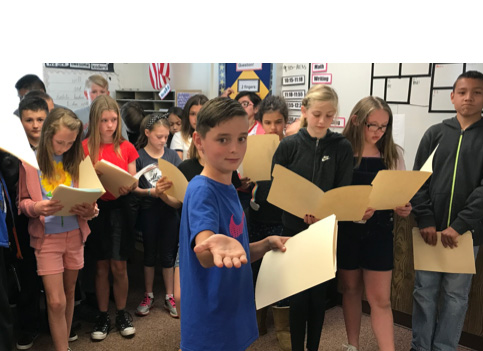
Lesson Summary
- Develop internet research skills.
- Identify key ideas from primary and secondary sources.
- Use nonfiction text to craft original reader's theatre pieces.
Lesson Plan and Procedure
Lesson Key Facts
- Grade(s): 5, 6
- Subject(s): Drama, Social Studies
- Duration of lesson: Four sessions, 45 minutes each
- Author(s): David Dynak
Note: This lesson is one of a group of lessons created to teach about the Transcontinental Railroad through the arts. Titles of the lessons can be found in the additional resources section below.
Listening and Responding
Session 1
Teacher: Today we begin the process of creating original readers’ theatre pieces based on the history of the Transcontinental Railroad—from thinking, to planning, to building, and to the railroad’s short-term and long-term effects on our country. Let’s start by “reading” this picture (project the photo at the beginning of The New Newsies [see additional resources] on a whiteboard or screen).
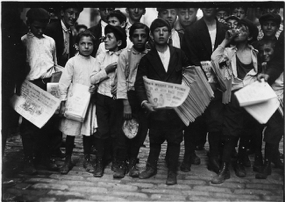
What do you see in this picture? Where do you see that?
Rather than ask students to raise hands, simply start at one point in the classroom and move from desk to desk or seat to seat. If a student doesn’t have an immediate response, move on, but tell the student, “We’ll come back to you.” When responses have dissipated, read the following summary of the newsboys’ strike.
Teacher: “Hawking newspapers in the 19th century was hard work. Rather than working for the newspaper itself, a newsboy—usually a kid or young teen from a poor family, often homeless himself—had to buy copies of the paper from the publisher, then sell them independently.
“An estimated 10,000 newsboys worked the streets of New York City. Publishers wouldn’t buy back unsold copies of their papers, which made it tough for a kid to eke out a profit.
“In 1899, the Evening World and Evening Journal started charging newsboys 60 cents for a hundred copies of their papers, a hike from 50 cents. [Angered,] thousands of newsboys went on strike. They held protests all over Manhattan and got into fights with men and boys hired by the papers as replacement workers.
“But the strike worked. After a few weeks of gloating media coverage in other New York City papers, the publishers scaled back the price hike.”
Teacher: Note a couple of things about the above summary: 1) No mention is made of newsgirls; 2) no mention is made of the leaders of the strike or how long it went on; 3) no mention is made about the owners of the newspapers or about the kind of news those newspapers tended to publish.
The source for the above story can be found here: http://ephemeralnewyork.wordpress.com/2009/10/26/the-newsboy-strike-of-1899/
Teacher: Those are all important things to know, right? And there is a lot more we could research. We could find other 1899 NYC newspapers to see how they were covering the strike. We could look for websites that contain photographs. We could try different ways of framing our search question.
Project The New Newsies script on the whiteboard.
Teacher: But today, we are going to use the “newsboys”—and “newsgirls”—strike of 1899 to kick off our work on the Transcontinental Railroad.
Complete a read-around of The New Newsies (see additional resources).
Teacher: As we look at the way this script is written, we can see that there are empty brackets in front of each line. Those brackets indicate where we would write one of your names if this were our final script. Today we are simply going to start with this part of the room and move around the room, person by person. So, let’s have at it.
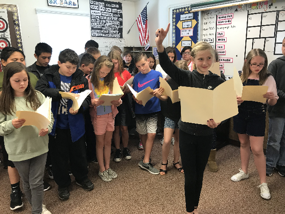
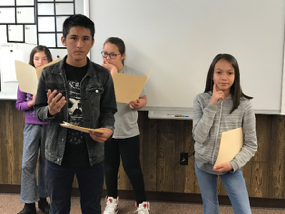
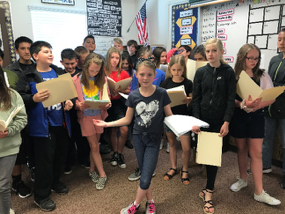
After completing the read-through of the script, explore The New Newsies for structure—an entrance, a physical arrangement of readers, lines that sometimes are fragments but other times are complete sentences, etc. Plus, note how the insertion of select choral lines emphasizes meaning. Ask your students to note how the text was derived from web-based research, posing questions and following the leads presented by search engines. Then, on a whiteboard, show students how to use the edit tab and copy and paste functions to build a rough draft. Help them to understand that by taking copy from websites and pasting it into a Microsoft Word document, they can “finish” by cutting long lines into short lines and organizing text into a beginning, a middle, and an end.
To end session one, divide the class into small groups of six or seven. Each group then meets to select two or three questions from the end of The New Newsies that the group wants to research. The aim is to achieve consensus in the selection of questions, so that groups can avoid duplicating each other’s questions.
Session 2
Teacher: Today we’re going to launch our web-based research.
Write the following steps on a whiteboard.
Step one: Divide the questions among your group members.
Step two: Launch your web research.
Step three: Each member of your group will open an MS Word doc to copy and paste the information that answers your question(s).
Step four: With 15 minutes to go in this session, print each of your docs, and, using a yellow highlighter, identify your most important sentences, phrases, and words.
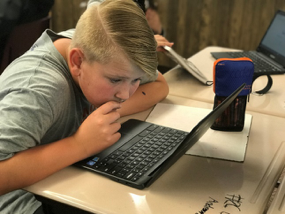
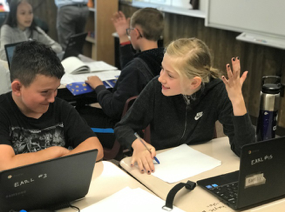
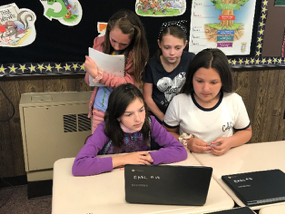
Next, have group members decide on the most important ideas from their search and sequence their ideas in whatever manner they choose (e.g., second-most important idea, third-, fourth-, fifth-, sixth-most important idea, ending with the most important idea; or starting with the most dramatic idea and ending with a restatement of that idea).
If you have the ability to do so, compile and save a digital master document.
Session 3
Teacher: We will begin by selecting a compiler/editor who will type a rough draft of the script as group members offer lines from their highlighted research. Once your draft is finished, do a read-through, editing as you go. Add appropriate choral lines. Finally, add brackets and assign a reader for each line.
Stop their work with 15 minutes to go in the session.
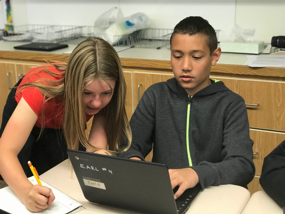
Teacher: To end this session, we are going to create a rubric we can use to assess our work. Some of the areas we should include are the richness of our research, the flow of our script, and the quality of our vocal work. Is there anything else we should include?
Teacher: I will compile our rubric. Should we use “yes” and “no” for each of our criteria? Or should we use indicators like “excellent,” “good,” “fair,” and “needs more work”?
Select the format for the rubric.
Session 4
Teacher: We are almost ready to share our work. But before we do, each group should conduct a self-assessment using our rubric. After your self-assessment, make any last-minute changes you find necessary, and do a final rehearsal “run.” Finally, decide on an entrance, and rehearse a curtain call.
Each group shares their work with the class.
Learning Objectives
- Gain a greater understanding of the roles people played in the building of the Transcontinental Railroad.
- Learn how to communicate meaning using the voice through volume, pitch, tone, rate, and clarity.
- Work in a group, create, perform, and respond to the use of nonfiction text crafted into original reader's theatre pieces.
Utah State Board of Education Standards
This lesson can be used to meet standards in many grades and subject areas. We will highlight one grade’s standards to give an example of application.
Grade 5 Social Studies
Standard 5.4.1: Use evidence from multiple perspectives (for example, pioneers, 49ers, Black Americans, Chinese Americans, Native Americans, new immigrants, people experiencing religious persecution) to make a case for the most significant social, economic, and environmental changes brought about by Westward Expansion and the Industrial Revolution.
Grade 5 Drama
Standard 5.T.CR.4: Define roles, identify responsibilities, and participate in group decision making.
Standard 5.T.CR.7: Recognize that participating in the rehearsal process is necessary to refine and revise.
Standard 5.T.P.2: Perform as a productive and responsible member of an acting ensemble in both rehearsal and performance situations
Standard 5.T.P.3: Observe, listen, and respond in character to other actors throughout a scripted or improvised scene.
Standard 5.T.P.5: Communicate meaning using the voice through volume, pitch, tone, rate, and clarity.
Equipment and Materials Needed
- A copy of The New Newsies: Uncovering the Stories Buried beneath the Golden Spike (theater piece) for each student
- Chrome books, iPads, or access to a computer lab
- Simple props, as needed
Additional Resources
This lesson is supported by the National Endowment for the Arts and the Utah Division of Arts & Museums
- This is one of several lessons created to teach about the Transcontinental Railroad. The other lessons in the unit include the following:
- Documents
- Rich visual and narrative treatment of the newsboys strike can be found at http://www.boweryboyshistory.com/2010/06/newsies-vs-world-newsboys-strike-of.html.
- For primary sources, you can search for "newsboys strike 1899" in ProQuest Historical Newspapers, The New York Times, or ProQuest Historical Newspapers: New York Tribune.
- There are many ways to use text (e.g., fiction, poetry, song lyrics) for readers’ theatre presentations—either for audiences or informally as classroom explorations of text. Additionally, there is a myriad of websites that provide scripts for readers’ theatre work. One source that expands on the model presented in these lessons was developed by Facing History and Ourselves: https://www.facinghistory.org/resource-library/teaching-strategies/readers-theater.
Image References
Image 1: Brenda Beyal.
Image 2: https://www.boweryboyshistory.com/wp-content/uploads/2010/06/newsies2-560x372.jpg
Images 3–9: Brenda Beyal.

www.education.byu.edu/arts/lessons
 Download
Download